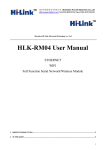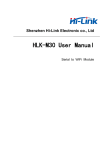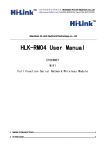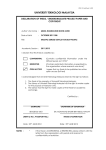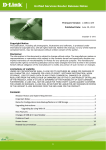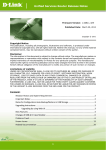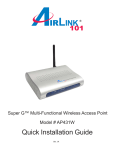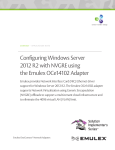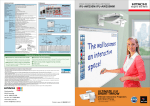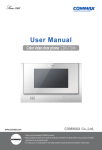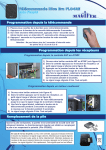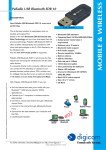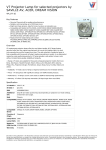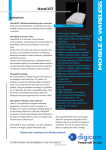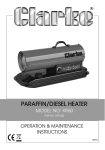Download high power router test report
Transcript
HIGH POWER ROUTER TEST REPORT “HIGH POWER” user's manual Quick Install Guide Cable DC Power Adapter Wireless Local Area Network,also known as WLAN (Wireless LAN),has become a popular network mode with more and more users. It is quite convenient for users since there is no need to wire.When we use it , sometimes we may find that the wireless signal is unstable, data transmission speeds may slow down. A router of high quality should be equipped with the following functions. 1. Reasonable design of basic hardware ,safe, reliable, low power consumption, long life span ; 2. Stable and applicable software which provides value-added upgrade service; 3. Long-distance stable transmission of wireless signal requires broad bandwidth and wide coverage, Among them the third point is the problem of industry, because the RF recognized the size of wireless transmission power and the transmission distance is proportional to relationship, but vast quantities of power radiation on human safety is harmful, and therefore must enhance wireless signals, the only way is to improved antenna, enhance antenna gain, reducing the wireless signals loss in transit, and then combining of mainboard, which all improve spectrum efficiently.BL-WH01 use a new type of high power gain antenna - aperture type phased antenna, this technology has in patent application, and it is anticipated to get patent certificate in June2012. 1 http://www.hlktech.com First we make a simple comparison between the ordinary dipole antenna and the aperture type phased antenna: Aperture type phased antenna The common Original Dipole antenna baffle-board Control chip Schematic of signal coverage 2 http://www.hlktech.com Signal schematic of aperture type phased antenna From the diagram of above we can see it is a prominent superiority for this new type of aperture type phased 1. With aperture and linear transmission, effective anti-interference ,farther distance of transmission and strong penetrating power 2. Increase s phase control chip, transmission efficiency is higher; 3. Design s a reflex plate and high power gain,that can recycle signal that reflects by multiple paths Electrical specifications Frequency Range 2.40-2.50 GHz VSWR Peak Gain 12dBi typical Efficiency 1.5:1 typical >90% Isolation Polarization >30dB typical Linear HPBW/Azimuth HPBW/Elevation 41℃ Front-to-back ratio 21dBc 53℃ Impedance 50Ohm According to this new type,software of HighPower r outer improves technical algorithms of OFDM and FEC to counter the effect of multipath transmission, noise and non line-of-sight (NLOS) environment. Capability which enhanced by OFDM modulation technique,makes client get a stable wireless connection under non line-of-sight environment or approximate visual environment. 3 http://www.hlktech.com Figure of outdoor signal test NOTE: 1. The router need to keep a certain distance from the ground, the higher position where router puts on, the farther distance of wireless transmission. 2.Weather will take a certain extent effect for wireless signal transmission 3. There isn't any building in the test area 4. There is no strong signal source with strong interference (such as GSM signal pad) HLK-HPR01 2.2M HLK-HPR01 router,Lenovo Z460 notebook,150M wireless card 4 http://www.hlktech.com Figure of outdoor signal coverage 2000 M y G1 F1 1000 M E1 800M D1 600 M C1 300 M B1 A1 1500 M 1200 M 2000M G 1500M 1200M F 1000M 800M 600M 300M D C B A E 300M A 600M B 800M 1000M C D 1200M 1500M E F 2000M G x 300M A1 B1 C1 1000 M 1200 M D1 E1 1500 M F1 2000 M G1 600M 800M Note: According to different wireless cards of clients ,the actual distance and speed transmission will vary . 1.The router should be placed vertically, in order to get the best wireless signal. 2.the strongest signal is from the positive and negative sides of router Test results 5 position A B C D E F G Signal strength% 85 72 65 55 42 30 10 Nic speed Mbps 135 135 108 54 54 30 11 position A1 B1 C1 D1 E1 F1 G1 Signal strength% 75 30 10 Nic speed Mbps 108 30 11 http://www.hlktech.com Compared with ordinary router A B M A: HLK-HPR01 B:Ordinary router 6 http://www.hlktech.com Indoor wireless test Generally,the outdoor distance of routers that sold on the market is well, but it will be difficult to cover 100 square meters indoor, the reason is very simple, in be used actually, 2.4 G waves are absorbed or reflected by those objects such as the ground,obstacles blocking. Signal attenuation loss serious. These obstacles are known by us like walls, partitions, floors, glass, doors,windows and so on.The size,thickness and structure of obstacles is different, impact is not the same degree. According to the experiment, Value of building penetration loss that 2.4G radio wave through a variety of building materials as below: A. Wooden walls (5 ~ 10cm) : attenuate 5 ~ 6dB B. Glass (0.5 ~ 1cm) : attenuate 5 ~ 7dB C. Concrete wall (15 ~ 25cm) : attenuate 10 ~ 12dB D. Steel mixing with water walls (25 ~ 45cm) attenuate 25 ~ 33 dB HLK-HPR01 Real Imaging figure 7 http://www.hlktech.com Indoor design renderings HLK-HPR01 8M 35 55M M Note: 1. Keep away from cordless phones, microwave ovens, refrigerators and other interference sources; 2. When there are some other 2.4G access points around,it is required the interval is more than 12M and avoiding the adjacent channel; 3. The router position appropriate to high place,so that the wireless signal coverage will better; 4. Keep away from the troubled waters of steel objects, walls or metal railings,because they can attenuate or absorb signal; 5. Note,it should be placed indoors and avoid the sunshine and rain or lightning; 6. Keep away from fire and heat, attention to ventilation. Test results Position Partition number Test distance Test data 8 * 1 5walls 15.6M signal:65% 90Mbps * 2 * 3 * 4 * 5 4walls 2walls 3walls 4walls 9M 13M 17M 18M signal:75% signal:75% signal:95% signal:50% 150Mbps 120Mbps 150Mbps 60Mbps * 6 * 7 5walls 4walls 30M 23M signal:80% signal:50% 150Mbps 60Mbps * 8 5walls 33M signal:42% 54Mbps http://www.hlktech.com Testing between the floors schematic diagram HLK-HPR01 72% 8F The 2.4G radio wave through steel and concrete walls is very difficult, most wireless routers do not really through it. But in actually use, many families and companies want to share wireless network cross-floor. HLK-HPR01 can meet this demand, its effect has been accepted with a lot of companies and hotels customers,it does not mean that this product will be able to penetrate the thick walls of steelconcrete, but means the antenna is hole-beam style transmission, good anti-jamming and strong penetrability, it reduces the transmission loss. Of course, after reflected by objects, signal is very strong, users in different floors can access to wireless Internet and work rely on the stability of the reflected signal. A7F 58% 96% 7F A6F 88% 88% 6F A5F 75% 80% 5F A4F 60% 65% 4F A3F 26% 45% 3F A2F 40% 42% 2F A1F 45% 50% 1F 60M B A Test results Position Signal strength% Nic speed Mbps Position Signal strength% Nic speed Mbps 1F 50 60 A1F 45 45 2F 42 45 A2F 40 40 3F 45 60 A3F 26 30 4F 65 90 A4F 60 90 5F 80 135 A5F 75 120 6F 88 150 A6F 88 135 7F 96 150 A7F 58 90 8F 72 120 Note: The signal strength is associated with distance between A and B building,height of building and the environment around . 9 http://www.hlktech.com LAN+WAN test result This test uses the Chariot 5.4 software ,a common software accepted by industry operators. IxChariot texts the network and network equipment by simulating a variety of real applications. Advantage of doing this test is to verify the performance of network or network device in specific applications . For any network or network device , if its performance is good in actual application , then we can consider that all aspects of the network system is good,and this is where the characteristics of the application layer testing. The topology for this test and measurement results are shown as below: 100 pairs WAN and LAN download and upload speed test 94.737M compare with the average speed value of ordinary router, it is stabler 94.446M compare with the average speed value of ordinary router, it is stabler Note:100 pairs LAN and WAN upload speed test and download speed test should be on the LAN PC LAN port mapping, to avoid the built-in firewall prevent the router from the WAN Active connections, resulting in test failure. 10 http://www.hlktech.com Basic RF Testing Transmit Spectrum Mask Procedure 1.Configure the hardware setup as Test Environment. 2.Select test channel and set “Conti. Tx” from the QA test utility. 3.Record the transmit spectrum mask from Spectrum Analyzer. Pass Criteria For transmitted spectral mask for 11n 20MHz shall be less than –45dBr for fc–30MHz<f<fc+30MHz. 11 http://www.hlktech.com Standards and protocol WAN One 10/100M self-adapting RJ-45 WAN port (when working in gateway mode,it's a WAN port,when working in other modes,it's a LAN port) LAN Four 10/100M self- adapting RJ-45 LAN ports Frequency Range 2 . 4 - 2 . 4 8 35GHz Wireless Signal Rates 11n: Up to 300Mbps 11g: Up to 54Mbps 11b: Up to 11Mbps port Working channel spread spectrum Modulation Technology Wireless parameters Receiver Sensitivity @PER transmission range RF power Antenna Network Media LED 12 IEEE 802.11n、IEEE 802.11g、IEEE 802.11b、IEEE 802.3、IEEE 802.3u、 CSMA/CA、CSMA/CD、TCP/IP、DHCP、ICMP、NAT、PPPoE WLAN WAN LAN Other 1~14 channel (according to the country or region you choose) DSSS (Direct Sequence Spread Spectrum) DBPSK、DQPSK、CCK and OFDM(BPSK/QPSK/16-QAM/64-QAM) 3 0 0 M:-84dBm@10% PER 150M:-84dBm@10% PER 130M: -84dBm@10% PER 108M: -84dBm@10% PER 54M: -87dBm@10% PER 11M: -87dBm@8% PER 6M: -100dBm@10% PER 1M: -102dBm@8% PER Indoor: 300M;outdoor: 2000M (depends on environment) 20dBm EIRP 12dBi high-gain omnidirectional antenna 10Base-T:3e UTP or above; 100Base-TX:5e UTP Link/Act (connection/working) Link/Act (connection/working) Link/Act (connection/working) SEC(WPS status)power Unit’s dimensions (L×W×H) (mm) 180 × 140 × 58 Operation environment Operation temperature:0℃~45℃;Operating Humidity: 10%~90%(non-condensing) Storage temperature:-40℃~70℃;Storage Humidity: 5%~90%(non-condensing) External power Power adapter output: DC12V/1A http://www.hlktech.com :// . Appendix ◆Transmitting antenna from the router directly to the wave hitting the receiving point is called direct wave; as the waves hitting the ground, by ground reflex and reach the waves called method-the peak-trough reflection wave. Obviously, the receiving point of the signal should be direct and reflected waves synthesis. Shows the presence of ground reflection, making the signal strength of the spatial distribution becomes quite complex, BL-WH01 although optimized synthetic wave, but the receiver the quality of the wireless network card is also very critical, the farther distance, the quality requirement of the wireless network card is higher also, for example in the fight against multi-path waves, the ability to filter noise better than some. ◆ That the actual measurement: beyond a certain distance Ri, with the distance from the antenna height increases or reduction in signal strength will plummet. Theoretical ideal distance Ri and are given a high degree of HT and the receiver antenna height HR of the relationship: Ri = (4 HT * HR) / L, then L is the wavelength.For example, HT and HR are set as 3m and 3 m, wireless transmission within Ri =288m would be relatively ideal. ◆When 2.4G radio waves transmit, it will come across obstacles (like high building,hill etc) which reflect waves ,so there will be multiple reflected wave(generally, ground reflected wave is included) ,this phenomenon is called multi-path propagation. Since there is multi-path propagation,spatial distribution of signal strength is very complicated,it fluctuate wildly and will increase in some place but reduce in other place. With the effect of multi-path propagation,direction of wave polarization will change ,besides, there will be defferent reflecting capacity between different obstacles.For example,the reflecting capacity of concrete structures is stronger than the capacity of brick wall. We need to overcome the negative effects of multi-path propagation . ◆Meanwhile,we have to know diffraction propagation of waves,electromagnetic wave will diffract spread when there is an obstruction, electric wave spread will bypass the obstacles and go ahead. This phenomenon is called wave diffraction. diffraction of a 2.4G microwave is weak, behind the tall buildings signal strength is small, there will form a "shadow areas". This signal quality will be affected. For example there is a building, its height is 10m, quality of receiving signal barely affected in a distance of 100m behind the building, but in 50m, receiving signal decreased obviously than 100 m. ◆According to the experience, when setting a same frequency between each adjacent wireless router, it will be requested interval 25 meters or more; when setting an adjacent frequency between each adjacent wireless router, it will be requested interval of 16 meters or more; when setting an apart frequency, it will be required intervals 12 meters or more. To keep a good quality of WLAN, you need to consider the number of users, it should not exceed 30 wireless users or 200 wire users online when using one single wireless router At present, many wireless routers support WEP,WPA and WPA-2PSK encryption algorithm , it will enhance the security of home networks, but it also affects the speed of data transmission more or less. 13 http://www.hlktech.com














